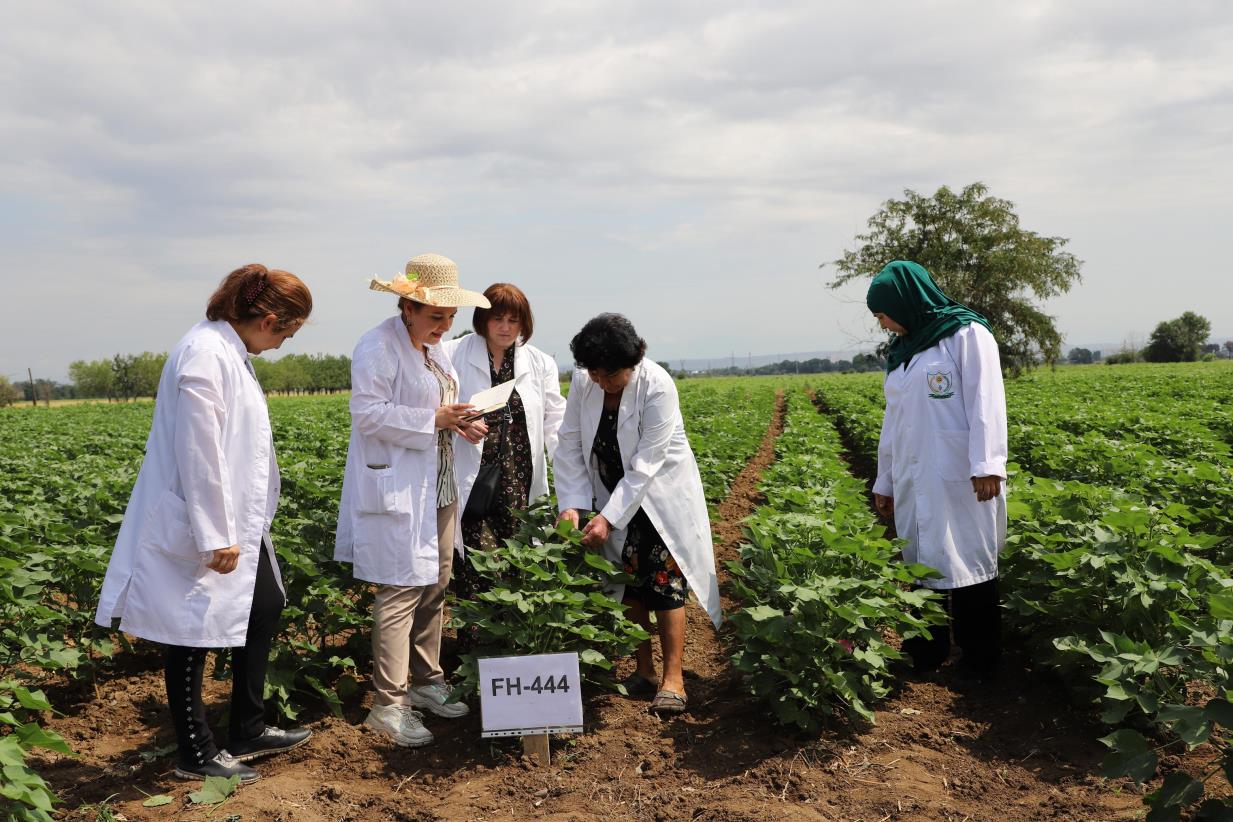
Reviving Azerbaijan’s cotton industry with nuclear techniques and climate-smart agriculture
Joint FAO/IAEA Centre provides new solutions to soil degradation and climate change challenges
Through the Joint FAO/IAEA Centre of Nuclear Techniques in Food and Agriculture, researchers and farmers in Azerbaijan have been working to revitalise the local cotton industry by implementing climate-smart agriculture practices based on nuclear and related techniques. ©FAO/Asim Hafeez
31/07/2023
The first traces of cotton growing in Azerbaijan date back thousands of years. During the Soviet era, it was referred to as "white gold," accounting for approximately 25 percent of agricultural revenue. However, the transition to a free market economy, coupled with the rapid growth of alternative industries in the 1990s, contributed to cotton losing its key role. Production fell to a record low of 31 000 tonnes in 2009, compared to more than 830 000 tonnes in the 1980s.
Thanks to a project supported by the Food and Agriculture Organization of the United Nations (FAO) and the International Atomic Energy Agency (IAEA), through the Joint FAO/IAEA Centre of Nuclear Techniques in Food and Agriculture, researchers and farmers in Azerbaijan have been working to revitalise the local cotton industry by implementing climate-smart agriculture (CSA) practices based on nuclear and related techniques.
Combined with the use of an improved variety of cotton, the project has boosted yields, from a national average of three tonnes per hectare to eight tonnes per hectare at field level in three provinces.


Isotopic techniques help Azerbaijani researchers and farmers obtain key information on how to optimize fertilizer use and increase the efficiency of cotton production while maintaining soil health. ©IAEA/Mohammad Zaman
It all started in 2021, with a pilot project that focused on training Azerbaijani researchers and farmers on CSA practices through on-farm demonstrations.
In 2022, a second project then focused on imparting best practices in soil, nutrient and water management, as Azerbaijan’s land is particularly vulnerable to climate change and soil degradation. The country has experienced an average annual temperature rise of 0.4 degrees Celsius since 1991, as well as lower rainfall and more frequent extreme weather events, such as floods, droughts or heat waves.
“Generally speaking, 60 percent of the improvement in crop productivity comes from capitalising on the strategic application of soil nutrients and water management,” said Mohammad Zaman, a soil scientist at the Joint FAO/IAEA Centre and the Technical Officer of the project. “It’s about the right amount, in the right way, at the right growth stage.”
“When we started, Azerbaijan’s soils were heavily degraded. The fertility was very poor, and so the soil did not have the capacity to provide all the essential nutrients required for cotton growth,” Zaman added.
To address this, the FAO/IAEA project rolled out a complete package of nuclear and related techniques for farming: from preparing soil and selecting the best cotton varieties, to applying nutrients and irrigation to the fields and ensuring weeds, pests and diseases were under control.
“Applying improved soil, nutrient and water management practices, along with using the improved cotton variety, has led us to increase our cotton productivity, quality and profit,” said Sakhavat Mammadov, an Azerbaijani farmer who took part in the project and has been using CSA practices on his farm for the last two years.

Climate-smart practices and nuclear or nuclear-related techniques not only help increase agricultural productivity but also build the resilience of agricultural systems to climate change. ©IAEA/Mohammad Zaman
Nuclear tracing
In Azerbaijan, the researchers used a technique involving nitrogen-15 (N-15), a stable isotope that is used as a tracer of nitrogen levels in the environment. Nitrogen plays an important role in plant growth and photosynthesis — the process whereby plants convert carbon dioxide and sunlight into plant food.
A lack of nitrogen and other nutrients in the soil leads to lower yields and less nutritious crops. The excessive or incorrect application of nitrogen fertilizers on the other hand, contributes to higher emissions of greenhouse gases and pollution of surface and groundwater.
“Cotton in Azerbaijan is expected to be one of the crops experiencing the greatest yield declines due to climate change and rapid soil degradation,” Zaman said. “Taking advantage of isotopic techniques, such as the use of N-15, can help adapt to this situation, making the cotton sector more competitive as well as ensuring employment and improving the welfare of the rural population.”
The project's outcome shows the significant potential of nuclear techniques and climate-smart practices. These techniques not only help increase productivity, but also build the resilience of agricultural systems to climate change.
“Considering a total cotton growing area of 105 000 hectares in Azerbaijan, a 10 percent increase of the climate-smart agricultural practices adoption, as introduced by the Joint FAO/IAEA Centre, could have the potential of increasing cotton production to 84 000 tonnes compared to 31 500 tonnes achieved through conventional farming practices,” Zaman said.
The success of the project has generated a lot of interest from the Ministry of Agriculture and the local cotton industry, and there are plans to further promote CSA practices in Azerbaijan.
“Our farmers have seen the benefits of CSA for cotton and now we are upscaling this technology to other areas to make a bigger impact on cotton production,” said Nazakat Ismayilzada, one of the project's local counterparts.
Related links
Learn more

